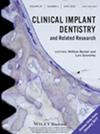Radiographic Outcomes of Transcrestal Sinus Floor Elevation With RBH ≤ 5 mm: Non-Perforation and Laterally Repaired Cases
Abstract
Objective
This study aimed to compare the clinical effects of implants placed in sites with a transcrestal sinus floor elevation (TSFE) featuring a residual bone height (RBH) of ≤ 5 mm, without Schneiderian membrane perforations, to those in sites where a lateral window approach was utilized to repair perforations that occurred during TSFE.
Methods
A total of 104 implants in 80 patients (80 sinuses) with RBH ≤ 5 mm who had undergone TSFE with simultaneous implant placement were included in this retrospective study. The implants were categorized into two groups based on whether the Schneiderian membrane was perforated, and the lateral window technique for sinus floor elevation (LSFE) was utilized to repair perforations that occurred during the TSFE procedure. The early implant loss, endo-sinus bone gain (ESBG), and implant apical bone resorption (ABR) were used to assess new bone formation between the non-perforated and the perforated groups.
Results
The non-perforation group consisted of 89 implants in 69 patients (69 sinuses), whereas the perforated group included 15 implants in 11 patients (11 sinuses). No early implant loss or postoperative complications were observed in either group during the first 6 months following implant installation. The ESBG was (5.83 ± 2.06) mm for the non-perforation group and (7.76 ± 1.63) mm for the perforation-repaired group (p < 0.001). A linear mixed model indicated that group (β = 2.41, 95% CI = 1.49, 3.33, p < 0.001) and RBH (β = −0.53, 95% CI = −0.80, −0.27, p < 0.001) significantly influenced ESBG. The ABR between the non-perforation and perforated group has no statistically significant difference (β = 0.84, 95% CI = −0.41, 2.08, p = 0.185).
Conclusion
Repairing Schneiderian membrane perforations that occur during TSFE in cases with RBH ≤ 5 mm, using the lateral window technique, leads to ideal internal radiographic bone augmentation volume maintenance in the maxillary sinus compared to cases without perforation; no significant difference in early implant loss was observed.
Trial Registration: Clinical Trial Registry: (ChiCTR2200062886)

 求助内容:
求助内容: 应助结果提醒方式:
应助结果提醒方式:


